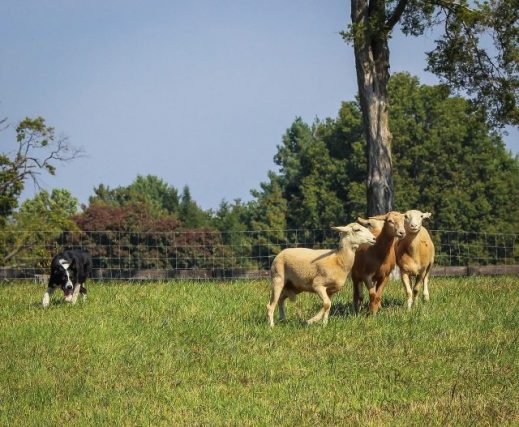Introduction
Herding dogs have been an essential part of agricultural life for centuries, helping to manage livestock and perform various farm duties. Developed around the world, these breeds are celebrated for their intelligence, trainability, and innate ability to control the movements of other animals. Herding dogs are not just working animals; They are efficient partners who communicate with their handlers and demonstrate natural skills for directing livestock. Each herding breed has unique characteristics, tailored to the specific type of work and environment for which they were bred. This article highlights seven dog breeds renowned for their natural herding abilities, exploring the specific traits and skills that make them adept at this demanding but rewarding work.
1. Border Collie
Hailing from the border areas between Scotland and England, the Border Collie is widely considered to be the most intelligent and capable herding breed. Originally bred to herd sheep, they are known for their keen eyesight or ‘eye’, allowing them to monitor livestock. Border Collies are incredibly agile, capable of making quick and precise movements that effectively guide animals. Their intelligence and eagerness to please make them highly trainable for a variety of herding tasks. Border Collies are also known for their stamina and ability to work on different terrains and in different weather conditions, making them versatile and indispensable herding partners.
2. Australian Shepherd
Despite its name, the Australian Shepherd was developed in the United States. These dogs were bred primarily to herd sheep and cattle on large farms, and they quickly became valued for their versatility and intelligence. Australian Shepherds are known for their ability to adapt to different herding styles, suitable for both close work and distance control. They are energetic and require a lot of physical and mental stimulation, qualities that make them excellent at managing large herds. Australian Shepherds also have a unique herding technique, often nipping at the heels to move the cattle while being agile enough to avoid kicking.
3. Belgian Malinois
The Belgian Malinois, originally bred in Belgium for herding and protective work, is a versatile breed known for its intelligence, agility, and herding ability. Although they are now more commonly seen in police and military roles, their herding instincts remain strong. Malinois have a natural tendency to herd moving objects, including people and animals. They are energetic and have a strong desire to work, which keeps them constantly engaged in their animal husbandry operations. Their trainability and responsiveness to commands make them effective in managing livestock, especially in situations that require quick and decisive action.
4. Shetland Sheepdog
The Shetland Sheepdog, or “Sheltie”, originated from the Shetland Islands of Scotland, bred to herd sheep, ponies, and poultry. These small but strong dogs are known for their intelligence, assertive herding style, and agility. Shelties are adept at maneuvering through tight spaces, a skill essential in the rocky and uneven terrain of their native lands. Their keen intelligence and eagerness to please make them highly trainable for herding duties. Despite their small size, Shelties have a commanding presence, using their bark and speed to effectively control and direct livestock.
5. Welsh Corgi (Pembroke and Cardigan)
Welsh Corgis, both the Pembroke and Cardigan varieties, have a history of herding cattle in Wales. Despite their small stature, Corgis are surprisingly agile and strong, able to outrun and control larger animals. They are known for their method of biting the heels of the animals and then ducking to avoid the kick. Corgis are intelligent and have a strong desire to work, making them consistent and effective herders. Their size allows them to be fast and agile, which is an advantage in tight quarters or grazing in rough terrain.
6. Old English Sheepdog
The Old English Sheepdog, with its distinctive shaggy coat, was originally bred in England to herd cattle and sheep to market. These dogs are known for their strength, stamina and herding instincts. When working with animals they have a calm but firm demeanor, using their size and presence to coax the animals to move. Old English Sheepdogs are intelligent and responsive to training, capable of performing a variety of herding tasks. Their thick coat protects against harsh weather, making them suitable for outdoor work in a variety of climates.
7. German Shepherd
The German Shepherd, although widely known for its roles as law enforcement and service dogs, also has a strong herding background. Originating in Germany, they were initially bred to herd sheep. German Shepherds are known for their intelligence, versatility, and ability to work long hours. He has a balanced herding style, capable of both forceful and gentle guidance, tailored to the needs of the situation. Their trainability and keen sense of duty make them reliable herding dogs, able to effectively manage and protect livestock.
These seven dog breeds, each with their own unique herding abilities and styles, demonstrate the diversity and skill within the herding group. From the precise and agile Border Collie to the strong and commanding Old English Sheepdog, these breeds have evolved to become experts in livestock management in their own distinctive ways. Their intelligence, energy and trainability not only make them excellent at herding but also highlight their ability to form close working partnerships with humans. The enduring legacy of these breeds in agricultural work underlines their importance in human history and their continued relevance in modern agricultural practices.

